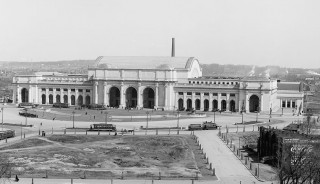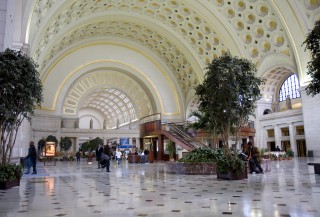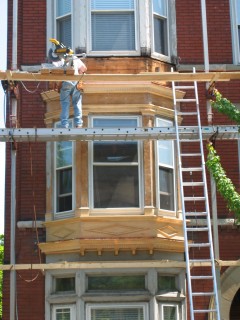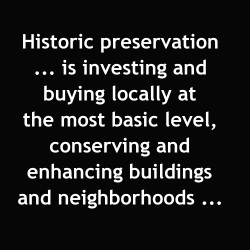Do you think of a famous historic site, beautifully rehabilitated historic neighborhoods, thriving older commercial districts, cultural economic development, job creation, and people working together? Or do you think of government regulation, opposition to new development, and increased project costs?
Maybe you’ve never really thought about it, wonder what it’s all about, and would like to learn more.
Whether you are a newcomer or a veteran, you know that planning commissioners wear many hats. That’s part of what makes the job both interesting and challenging.
In evaluating the pros and cons of land use issues affecting our communities we are, in the highest sense, called upon to act as community stewards, entrusted with the thoughtful and responsible management of our community’s unique assets and resources while minimizing threats and taking advantage of opportunities. A better understanding of historic preservation can help planning commissioners become more effective community stewards.
To set the stage for future posts, I thought it might be helpful to tell you how I became interested in historic preservation and why I think it’s important.
I grew up in the rapidly growing suburbs of Los Angeles, San Francisco, Chicago, and Washington, D.C. My family lived in housing developments so new that houses were in various stages of completion all around us and more subdivisions were being constructed in every direction. There wasn’t a hint of anything old, and history existed mainly in the names of subdivisions and streets, in tourist brochures and on isolated historic markers describing various sites and military skirmishes.
In this near absence of history, I became interested in old buildings when we visited my father’s city offices and on trips to visit relatives and cultural institutions in communities across the country.

My enthusiasm intensified when historic preservation efforts began at Washington, DC’s Union Station, the Old Post Office, Willard Hotel and other landmark buildings.

Over time, our family watched as Union Station was transformed from a filthy, leaking, mostly abandoned hulk with a vestigial Amtrak station into an animated mixed-use facility and transportation hub.
I was hooked during my college years, when a family friend purchased a heavily fire-damaged brownstone near Washington’s Capitol Hill and slowly rehabilitated it into space for her home, office, and an apartment, while also stimulating reinvestment in neighboring properties.

I am now rehabilitating my own three-flat brownstone as time and finances allow. I owe my good fortune to the passion and hard work of a neighbor, an energetic retired gentleman who has always spent his free time buying dilapidated old buildings, restoring them, and turning them over to new owners, tenants or businesses. A former Peace Corps volunteer, he celebrates community and the process of reversing neighborhood blight. After purchasing a poorly remodeled circa 1840 frame residence, he made a very public project out of its restoration, inviting anyone interested to observe his progress from beginning to end.
In doing this, he essentially created a new community, attracting many other buyers (including me) to relocate to the neighborhood and rehabilitate additional buildings. Our once downward spiraling block is now dominated by rehabilitated buildings, new businesses, and new owners and tenants; our neighbor has completed four other projects, catalyzing rehabilitation of three nearby blocks, attracting several new owners, and inspiring numerous others to undertake similar catalytic projects throughout the city.
While these accomplishments have mostly happened through individual efforts outside our city’s historic districts, historic preservation also occurs through more formal efforts to identify, protect, enhance, promote, and interpret a community’s historic and cultural resources. Such efforts often involve historic resource surveys and preparation of historic preservation plans, adoption of local historic preservation laws and design review, listing of buildings and districts in the National and State Registers of Historic Places, and creation of incentives and heritage tourism programs.
 Although I’ve seen failures as well as successes, historic preservation is one of the best ways I know to make the most of old buildings, maintain and build on community character and history, and invest responsibly for future community growth. It is investing and buying locally at the most basic level, conserving and enhancing buildings and neighborhoods resulting from previous public and private investment, creating local jobs, and providing updated spaces for living, working, dining, performing, learning and so much more.
Although I’ve seen failures as well as successes, historic preservation is one of the best ways I know to make the most of old buildings, maintain and build on community character and history, and invest responsibly for future community growth. It is investing and buying locally at the most basic level, conserving and enhancing buildings and neighborhoods resulting from previous public and private investment, creating local jobs, and providing updated spaces for living, working, dining, performing, learning and so much more.
It has been almost 50 years since the National Historic Preservation Act went into effect, but many people still misunderstand and have misgivings about historic preservation. So, regardless of how you might answer my opening question, we can all benefit from expanding our knowledge, celebrating accomplishments, and sharing ideas, experiences and lessons learned.
I look forward to writing this column; feel free to ask questions and give topic suggestions in the comments!